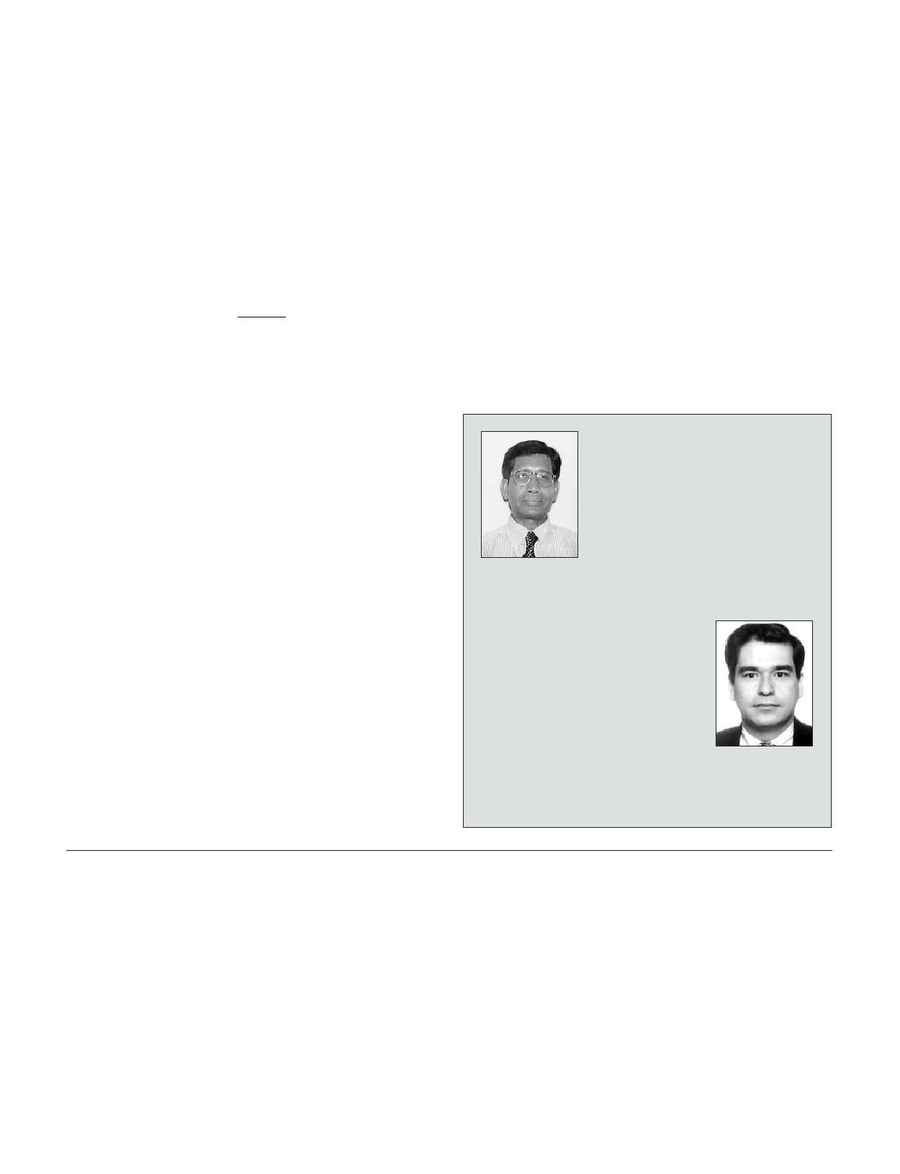
defined for both modeling and reactor material bal-
ance. This representation also allows estimation of the
reaction equilibrium constants from standard free ener-
gies of formation of the model compounds. Although
model compounds have been used to represent com-
pound groups, actual molecular weights of these com-
pound groups as estimated from the detailed compo-
nent analysis of the feedstocks are used in the reactor
model to simulate actual gas densities and mass
throughputs into the reactor.
A reaction mechanism based on model compounds
is listed in Table 3. Rate expression for each reaction
is obtained assuming an elementary reaction. For
instance, the rate expression for reaction 1 becomes:
where:
r
1
rate of reaction 1
k
01
, E
1
pre-exponential factor and activation
energy of reaction 1
R, T
gas constant, reaction temperature
C
1
,C
7
,C
2
,C
4
molar conc. of nPC
9
H
20
, H
2
, nPC
6
H
14
and C
3
H
8
respectively
K
1
equilibrium constant of reaction 1.
Preliminary values of reaction activation energies
are found in open literature on the kinetics of similar
reaction systems. Using these values of activation ener-
gies, the reaction pre-exponential factors are then
obtained by matching a preliminary set of experimen-
tal data with model predictions. All rate parameters
(k
0
and E values) are finally refined by using all pre-
screened experimental data and a parameter estimation
routine. Pilot plant performance of the above process
using several feedstocks and a wide range of operating
conditions were modeled satisfactorily.
In these examples, the general model was used
extensively to develop kinetic models for other reac-
tion systems. The data used in the development of these
kinetic models were again obtained from a variety of
reactor configurations at lab, pilot plant and commer-
cial-scale levels, and not just from ideal test units like
a differential and or an integral reactor. These devel-
opments were possible because the model is able to
extract true or intrinsic kinetics from almost any data
source irrespective of influences of various mass and
heat transfer effects and hydrodynamic conditions of
different reactors. The parameter estimation routine
is helpful when determining the kinetic parameters for
any reaction or reactor system.
Array of applications.
A general reactor model can
apply to any combination between reaction and reactor
systems. A general gas-solid reactor model such as the
one used in the above examples should apply to:
·
Catalytic processes, such as oxidation, oxychlori-
nation, ammoxidation, reduction, reforming, catalytic
cracking (including FCC), isomerization, hydrogena-
tion, dehydrogenation, shift/methanation, catalytic
burners and ultra-rapid pyrolysis
·
Homogeneous gas-phase systems, such as gas burn-
ers, combustors, incinerators, thermal crackers and
reactors
·
Noncatalytic gas-solid systems, such as catalyst
regeneration, hot gas desulfurization, mineral process-
ing, and gasification and combustion of solids.
r
k e
C C
C C
C C K
E
T
1
01
1
1
7
2
4
1
7
1
1
=
-
-
/ R
Dr. Dutta is a senior staff consultant for
GTC Technology Corp., specializing in
designing and implementing reactor models
to industry. He has published more than 30
papers and a book chapter describing work
in reactor modeling. He has served numer-
ous times on advisory boards and research
teams across the globe, addressing aspects
of chemical engineering and process mod-
eling. Dr. Dutta has a long history of indus-
try experience, spanning over 30 years, having held senior
positions for Simulations Sciences, SABIC Research and Devel-
opment, Engelhard, Fluor Daniel and CE Lummus Crest.
Ron Gualy is the business unit manager
for the dimethyl terephthalate (DMT) busi-
ness for GTC Technology Corp. He is
responsible for all marketing, research
and application activities for DMT licensed
technology worldwide. Mr. Gualy holds a
BS degree in chemical engineering from
Texas A&M University and is a registered
professional engineer. He is a member of
AIChE, American Chemical Society and
The American Management Association. Mr. Gualy holds four
patents concerning carboxylic acid recovery and has other
patents pending. He has been with GTC Technology since its
beginning six years ago.
Reprinted from Hydrocarbon Processing ® magazine, July 1999 issue, pgs. 45-53. Used with permission.
F/1M/899 Copyright © 1999 by Gulf Publishing Company. All rights reserved. Printed in USA.
